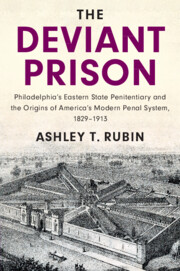 The Deviant Prison
The Deviant Prison from Part I - Becoming the Deviant Prison: Establishing The Conditions for Personal Institutionalization
Published online by Cambridge University Press: 12 January 2021
This Introduction identifies Eastern’s puzzling position in the landscape of nineteenth-century prisons: one of a few prisons, and then the only prison, to use a system of long-term solitary confinement. This chapter explores the historiography of Eastern and the early prisons looking for answers to the question of why one prison alone would continue to use a highly criticized mode of confinement? Turning to organizational theory, we find an answer in Philip Selznick’s “old” institutional theory. This chapter then identifies some of the ways in which a unique prison’s history helps us better understand the development of nineteenth-century prisons and penal change more generally. It concludes with some methodological notes.
To save this book to your Kindle, first ensure [email protected] is added to your Approved Personal Document E-mail List under your Personal Document Settings on the Manage Your Content and Devices page of your Amazon account. Then enter the ‘name’ part of your Kindle email address below. Find out more about saving to your Kindle.
Note you can select to save to either the @free.kindle.com or @kindle.com variations. ‘@free.kindle.com’ emails are free but can only be saved to your device when it is connected to wi-fi. ‘@kindle.com’ emails can be delivered even when you are not connected to wi-fi, but note that service fees apply.
Find out more about the Kindle Personal Document Service.
To save content items to your account, please confirm that you agree to abide by our usage policies. If this is the first time you use this feature, you will be asked to authorise Cambridge Core to connect with your account. Find out more about saving content to Dropbox.
To save content items to your account, please confirm that you agree to abide by our usage policies. If this is the first time you use this feature, you will be asked to authorise Cambridge Core to connect with your account. Find out more about saving content to Google Drive.